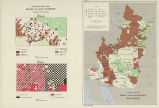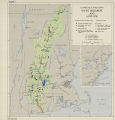| OCR Text |
exist for the future extension of navigation up the Columbia River to Chief Joseph Dam by channel improvements, the installation of locks at the authorized Priest Rapids and existing Rock Island Dam, and the construction of a dam and locks at the Rocky Reach site and at the Wells site. Further physically feasible improvements in the navigable waterways are (1) increase of channel depths either by dredging or flow regulation with reservoirs, (2) improvement of locks and facili- ties, and (3) the provision of needed improvements to serve harbors and terminals as they may de- velop. The accomplishment of these future navi- gation improvements should be contemplated when and as economically justified. Watershed Management and Sediment Control In order to extend the life of stream channel fa- cilities to provide maximum water utilization, and to obtain the most stable flow possible, improved watershed management is an integral element of the plan. Proper watershed treatment also is neces- sary to conserve and protect the productive capacity of the basin's soil resources. Provisions for such management should be basin-wide, and where physically possible are to precede construction of facilities whose life or operation is significantly af- fected by upstream water and erosion control measures. Watershed management includes: Use and treatment of the land surface so as to obtain minimum erosion and runoff consistent with the capability of the land for crops, pasture, forest, and other needed uses. Such measures as proper forest fire control, range reseeding, and re- forestation are included. Disposal of runoff, not otherwise detained, from fields and slopes through stable waterways and the temporary detention of such runoff in small upland storage basins wherever economically and physically practicable. Vegetative barriers and small debris basins to prevent erosional debris from clogging waterways and sedimenting of reservoirs, and stabilization and improvement of minor streams for reducing debris and managing disposal of flood runoff. Watershed management is not a substitute for, but complementary to major downstream flood control works. Commercial Fisheries It is proposed that the salmon, smelt, and steel- head trout fisheries of the Columbia River be maintained at the maximum level possible for as long a period into the future as preservation of fishery provides the most beneficial use of the waters of the Columbia and tributaries. This includes provision for such facilities as may permit the sur- vival of fisheries in their accustomed waters, and measures necessary to establish compensating spawning grounds for blocked streams. If appar- ently unresolvable conflicts enter in the final stages of the plan, whereby fishery production suffers ir- reparably by the construction of facilities for other uses, determination shall be made on a comparative benefit basis, weighing relative contributions of the part of the fishery affected and the proposed project as to their economic and social values, and contribution toward security needs of the region and the Nation. Pollution Abatement Because of the certain increase of industrial de- mands for water, exacting requirements of indus- tries for water quality, and the need for reduction of bacterial pollution to protect public water sup- plies and other legitimate water uses in parts of the basin, provision for requiring treatment of all harm- ful industrial wastes and all raw sewage is proposed except in those streams which have their highest economic use as waste carriers. A program of clearing accumulated health hazards and improv- ing water quality also is proposed. Ground Water Facilities Because the provision of adequate domestic and livestock-watering facilities is often dependent upon development of ground water in arid and semiarid parts of the basin, and because availability of such water supplies may make some stream-supplied irrigated lands more useful, a program of develop- ing ground water facilities is proposed for parts of the basin where they are needed or are likely to be needed. Recreation Developments Scenic and other recreational attractions are among the outstanding resources of the Pacific Northwest. The availability of water recreation facilities, however, is not evenly distributed over the region. Provision therefore should be made among elements of a full plan for reservation of water sup- plies, construction of supplementary facilities for 71 |


























































































































































































































































































































































































































































































































































































































































































































































































































































